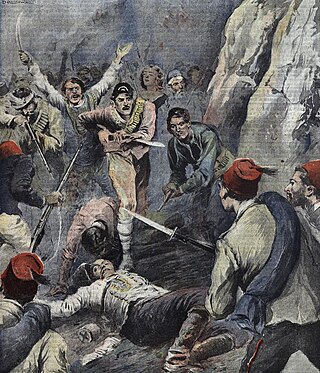
The history of Yemen describes the cultures, events, and peoples of what is one of the oldest centers of civilization in the Near East. Its relatively fertile land and adequate rainfall in a moister climate helped sustain a stable population, a feature recognized by the ancient Greek geographer Ptolemy, who described Yemen as Eudaimon Arabia meaning "fortunate Arabia" or "Happy Arabia". Yemenis had developed the South Arabian alphabet by the 12th to 8th centuries BC, which explains why most historians date all of the ancient Yemeni kingdoms to that era.

Isa Boletini was an Albanian revolutionary commander and politician and rilindas from Kosovo.

Yemen, officially the Republic of Yemen, is a country in West Asia. It is situated on the southern end of the Arabian Peninsula, and borders Saudi Arabia to the north and Oman to the northeast and shares maritime borders with Eritrea, Djibouti and Somalia. Yemen is the second-largest Arab sovereign state in the Arabian Peninsula, occupying 555,000 square kilometres, with a coastline stretching about 2,000 kilometres. Its constitutionally stated capital, and largest city, is Sanaa. As of 2023, Yemen has an estimated population of 34.2 million.

Sokollu Mehmed Pasha was an Ottoman statesman of Serbian origin most notable for being the Grand Vizier of the Ottoman Empire. Born in Ottoman Herzegovina into an Orthodox Christian family, Mehmed was forcibly recruited as a young boy as part of so called "blood tax" to serve as a janissary to the Ottoman devşirme system of recruiting Christian boys to be raised as officers or administrators for the state. He rose through the ranks of the Ottoman imperial system, eventually holding positions as commander of the imperial guard (1543–1546), High Admiral of the Fleet (1546–1551), Governor-General of Rumelia (1551–1555), Third Vizier (1555–1561), Second Vizier (1561–1565), and as Grand Vizier under three sultans: Suleiman the Magnificent, Selim II, and Murad III. He was assassinated in 1579, ending his near 15-years of service to several Sultans, as sole legal representative in the administration of state affairs.

The Sayfo or the Seyfo, also known as the Assyrian genocide, was the mass slaughter and deportation of Assyrian/Syriac Christians in southeastern Anatolia and Persia's Azerbaijan province by Ottoman forces and some Kurdish tribes during World War I.

The dissolution of the Ottoman Empire (1908–1922) was a period of history of the Ottoman Empire beginning with the Young Turk Revolution and ultimately ending with the empire's dissolution and the founding of the modern state of Turkey.

The 31 March Incident was a political crisis within the Ottoman Empire in April 1909, during the Second Constitutional Era. Occurring soon after the 1908 Young Turk Revolution, in which the Committee of Union and Progress (CUP) had successfully restored the Constitution and ended the absolute rule of Sultan Abdul Hamid II, it is sometimes referred to as an attempted countercoup or counterrevolution. It consisted of a general uprising against the CUP within Istanbul, largely led by reactionary groups, particularly Islamists opposed to the secularising influence of the CUP and supporters of absolutism, although liberal opponents of the CUP within the Ottoman Liberty Party also played a lesser role. The crisis ended after eleven days, when troops loyal to the CUP restored order in Istanbul and deposed Abdul Hamid.

The Battle of Dervenakia was the Greek victory over the Ottoman forces on 6-8 August 1822, an important event in the Greek War of Independence.
Najda ibn Amir al-Hanafi was the head of a breakaway Kharijite state in central and eastern Arabia between 685 and his death at the hands of his own partisans. His emergence formed part of the Second Muslim Civil War and the faction he led stood in opposition to the Umayyad Caliphate, which controlled Syria and Egypt, and the caliphate of Abd Allah ibn al-Zubayr, which controlled the Hejaz and Iraq.

Ihsan Nuri, also known as Ihsan Nuri Pasha, 1892 or 1893, Bitlis – 25 March 1976, Tehran) was a Kurdish soldier and politician, former officer of the Ottoman and Turkish Army, and one of the leaders of the Ararat rebellion as the generalissimo of the Kurdish National Forces.

The Second Egyptian–Ottoman War lasted from 1839 until 1840 and was fought mainly in Syria, where it is sometimes referred to as the (Second) Syrian War.

The siege of Svetigrad or Sfetigrad began on 14 May 1448 when an Ottoman army, led by Sultan Murad II, besieged the fortress of Svetigrad. After the many failed Ottoman expeditions into Albania against the League of Lezhë, a confederation of Albanian Principalities created in 1444 and headed by Skanderbeg, Murad II decided to march an army into Skanderbeg's dominions in order to capture the key Albanian fortress of Svetigrad. The fortress lay on an important route between present-day North Macedonia and Albania, and thus its occupation would give the Ottomans easy access into Albania. The force prepared by Murad was the largest force with which the Ottomans had ever attacked Skanderbeg. Murad planned to take the fortress, march into the Albanian interior, and capture the main citadel of Krujë, thus crushing the Albanian League.

The Idrisid Emirate of Asir was a state located in the Arabian Peninsula. The Emirate was located in the geographical region of Asir and Jizan in what is now southwestern Saudi Arabia, and extending to Hodeidah, northwest of Yemen.

The Albanian revolt of 1910 was a reaction to the new centralization policies of the Young Turk Ottoman government in Albania. It was the first of a series of major uprisings. Rebels were supported by the Kingdom of Serbia. New taxes levied in the early months of 1910 led to Isa Boletini's activity to convince Albanian leaders who had already been involved in a 1909 uprising to try another revolt against the Ottoman Empire. The Albanian attacks on the Ottomans in Priştine and Ferizovik, the killing of the Ottoman commander in İpek, and the insurgents' blocking of the railway to Skopje at the Kaçanik Pass led to the Ottoman government's declaration of martial law in the area.

The Ottoman campaign against Hormuz took place in 1552–1554. An Ottoman fleet led by Admiral Piri Reis and Seydi Ali Reis was dispatched from the Ottoman harbour of Suez to eliminate the Portuguese presence from the northwestern part of the Indian Ocean, and especially their fortress at Hormuz Island.

The Hauran Druze Rebellion was a violent Druze uprising against Ottoman authority in the Syrian province, which erupted in 1909. The rebellion was led by the al-Atrash family, in an aim to gain independence, but ended in brutal suppression of the Druze, significant depopulation of the Hauran region and execution of the Druze leaders.

Yemen Vilayet was a first-level administrative division (vilayet) of the Ottoman Empire. At the beginning of the 20th century it reportedly had an area of 200,000 square kilometres (77,200 sq mi). The population for the vilayet is given by the 1885 Ottoman census as 2,500,000.

The Yemeni–Ottoman conflicts were a series of conflicts between the Ottoman Empire and Zaidi tribes in Upper Yemen, which began in 1538 and ended with the signing of the Treaty of Daan on 9 October 1911.
The Zaraniq rebellion was an armed conflict in the lower Tihamah between the Mutawakkilite Kingdom of Yemen and the rebellious Zaraniq tribe that took place from 1925 to 1929. It has been referred to as a revolt, a civil war, as well as various other terms. It began in late 1925, and near the end of that year the Zaraniq would win a major battle against the Yemeni government. Over the next 2 years, large-scale fighting stagnated, with the only fighting taking place in the form of occasional raids. The rebels received arms supplies from Britain through the Ghulaifiqa port. By 1928, the rebels controlled an area stretching from Mansuriyah to Zabid. In June 1928, the Kingdom of Hejaz and Nejd sent 500 troops to aid the rebels. In October 1928, the Yemeni government dispatched an army to quell the rebellion, under the command of Sayf al-Islam Ahmad. Sayf marched from Sana'a to Bajil. At Bajil, he gave out that he intended to attack the Zaraniq capital of Bayt al-Faqih. However, this was merely a feint: Sayf instead attacked and captured the important rebel port of al-Ta'if. Despite the fall of al-Ta'if, rebel fortunes would see a temporary resurgence: A second army marching from al-Mukha was surprised and routed by the rebels. Bayt al-Faqih also resisted Sayf's attacks for most of 1929. These successes convinced the leader of the Zaraniq, Ahmed el Fiteini, to submit an appeal to the League of Nations for formal recognition as an independent state. However, the government's superior firepower would prove to be an insurmountable problem for the rebels, and in early October 1929 Bayt al-Faqih fell to the government and the Zaraniq surrendered, ending the rebellion.

Amanullah loyalism was a series of early-20th-century movements in the Kingdom of Afghanistan to restore Amanullah Khan as king of Afghanistan after he was deposed in January 1929 during the Afghan Civil War. Loyalists were sometimes referred to as Amanite. Loyalists tried to achieve this in various ways, including armed rebellions, political parties, colluding with foreign powers and assassinations. These movements petered out by the late 1940s. Amanullah died in exile in 1960 in Zürich, Switzerland, without ever regaining control, except a brief period of control in southern Afghanistan in the 1929 Afghan Civil War.


















